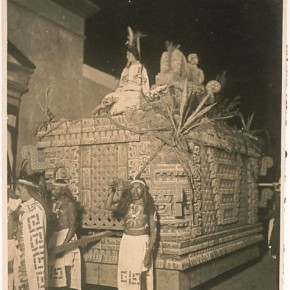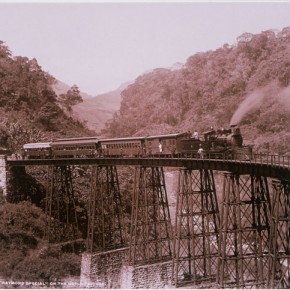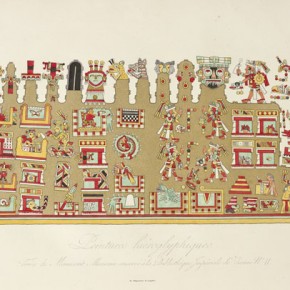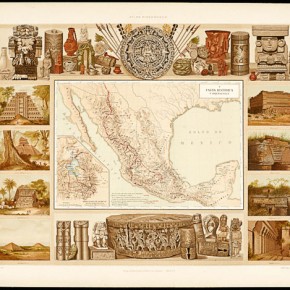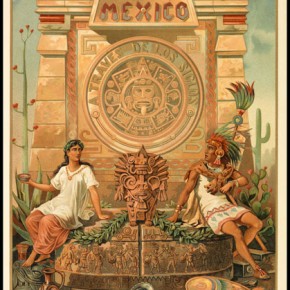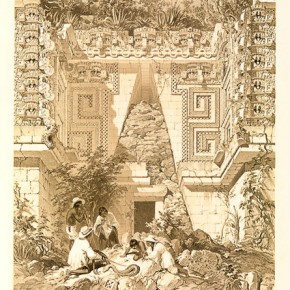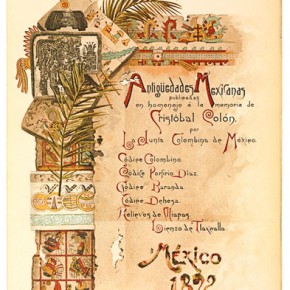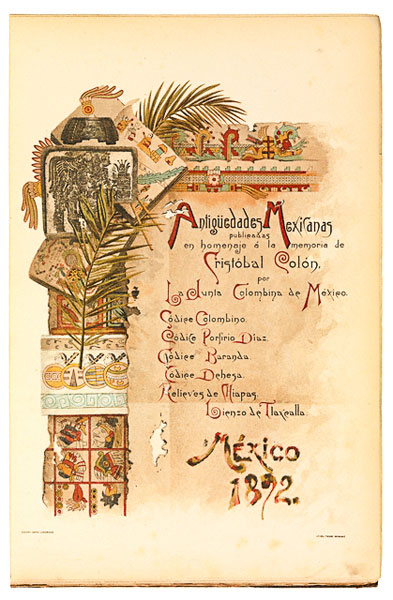
Atlas title page, Genaro Lopéz. Lithograph. Alfredo Chavero, Antigüedades mexicanas (Mexico City, 1892). Getty Research Institute.
Jan 1- Mar 27, Obsidian Mirror-Travels: Refracting Ancient Mexican Art and Archaeology, Getty Research Institute Exhibition Gallery, Los Angeles, Ca.
From the first moments of contact, Mexico’s indigenous civilizations evoked in their European conquerors an array of unsettling emotions ranging from fascination to fear. Eradicating populations, destroying monuments, suppressing native religions, and collecting and classifying cultural objects were among the methods used for containing and framing native cultures. Pre-Colombian Mexico, real and imagined, became the subject of innumerable books, treatises, and images. Each iteration assigned new meanings and contributed to the ever-evolving construction of ancient Mexico.
This exhibition explores representations of Mexican archaeological objects and sites made from the Colonial era to the present. Drawn mainly from the Getty Research Institute’s vast holdings of books, engravings, drawings, photographs, objects, letters, and postcards relating to Mexican archaeology, the exhibition features both well- and little-known images of ancient Maya and Aztec ruins made by archaeologist explorers such as Frederick Catherwood, Désiré Charnay, and Augustus and Alice Le Plongeon. Specific themes explored in the exhibition include the Aztec Calendar Stone, panoramic visions of Mexico, and Mexican antiquities in relationship to the nineteenth-century French intervention in Mexico, and later, during the long presidency of Porfirio Diaz (1876-1910).
The objects in this exhibition were created over the past five centuries by explorers, archaeologists, and artists who have in one way or another used Mexico’s Pre-Colombian past as a vehicle for their journeys. Each object is informed by the time and place in which it was made. None are pure reflections of the sites or artifacts they portray. All produce refractions, slices of an object that cannot be reassembled into a whole. As such, they are all mirrors that displace the time and space of ancient Mexico. http://www.getty.edu/research/institute/
- Parade float from President Porfirio Díaz’s visit to Yucatan, Merída, 1906. F. Gómez Rul (Mexican, active 1900s), Gelatin silver print. Getty Research Institute.
- Front cover, Anonymous. Color media on cloth. Vicente Riva Palacio, ed., México a través de los siglos…, vol. 2 (Barcelona, 1888–1889). Getty Research Institute.
- The Aztec Calendar Stone, Francisco de Agüera. Engraving. Antonio de León y Gama, Descripción histórica y cronológica de las dos piedras… que se esta formando en la plaza principal de México… (Mexico City, 1832), pl.2. Getty Research Institute.
- The Raymond Special on the Metlac Bridge, Veracruz, Mexico, ca. 1897. Charles Burlingame Waite. Gelatin silver print. Getty Research Institute.
- Section of the Vienna Codex, Unknown. Hand-colored etching and aquatint. Alexander von Humboldt, Vues des Cordilleres, et monumens des peuples indigenes de l’Amerique (Paris, 1810), pl. 47. Getty Research Institute.
- Carta histórica y arqueológica, Mexico City, 1885, Antonio García Cubas. Color lithograph. Atlas pintoresco y histórico de los Estados Unidos Mexicanos (Mexico, 1885), pl. 10. Getty Research Institute.
- Frontispiece, Anonymous. Lithograph. Vicente Riva Palacio, ed., México a través de los siglos…, vol. 1 (Barcelona, 1888–1889). Getty Research Institute.
- Archway, Casa del Gobernador, Uxmal. Andrew Picken after Frederick Catherwood. Chromolithograph. Frederick Catherwood, Views of Ancient Monuments in Central America, Chiapas and Yucatan (London, 1844), pl. 10. Getty Research Institute.
- Atlas title page, Genaro Lopéz. Lithograph. Alfredo Chavero, Antigüedades mexicanas (Mexico City, 1892). Getty Research Institute.

